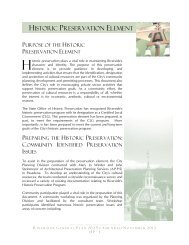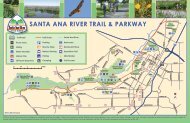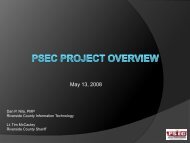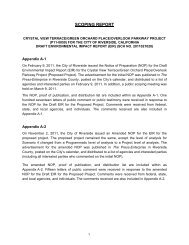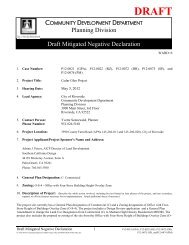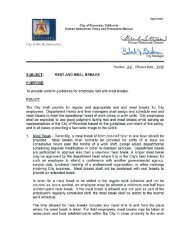Northside - City of Riverside
Northside - City of Riverside
Northside - City of Riverside
Create successful ePaper yourself
Turn your PDF publications into a flip-book with our unique Google optimized e-Paper software.
2974-3036 (1910-1924) Lime Street within the proposed St. Andrews Terraces Craftsman District<br />
Lastly, two Victorian Era grove homes have been modified and incorporated into<br />
early 20 th century tract development – the Shugart House (2973 Mulberry Street) and<br />
The Waite House (3063-65 Lime Street). In 1910, the Waite and Shugart grove<br />
property, which stretched between the two grove homes, were subdivided for<br />
development. The Waite House was altered so that its main entrance is now on Lime<br />
Street, its former side elevation. The Gothic Revival style home was been severely<br />
altered through the decades with Tudor and Craftsman inspired alterations and<br />
additions. The Shugart Home may have retained its original location until the arrival<br />
<strong>of</strong> SR-91 through the area in 1958. The home has been turned from its original<br />
orientation toward First Street and is now positioned on Mulberry Street, just south<br />
<strong>of</strong> the former Southern Pacific Company roadway, with it’s back to the Waite House<br />
and the surrounding development. It, too, has undergone a Craftsman facelift and is<br />
a contributing property to the proposed St. Andrews Terraces Craftsman District.<br />
With the nearest lands north <strong>of</strong> the Mile Square carved up, attention seems to have<br />
shifted to the next logical place to develop, and discussions about the feasibility <strong>of</strong><br />
filling in the Tequesquite Arroyo began. By the eve <strong>of</strong> America’s involvement in<br />
World War I, <strong>Riverside</strong>’s largest arroyo in a system <strong>of</strong> many had been filled (1913),<br />
allowing the growing population to spill into the areas southwest <strong>of</strong> the Mile<br />
Square, including the former Government Tract, which were covered by citrus<br />
groves and, to a lesser degree, vineyards and walnut orchards. In this area, 18<br />
subdivisions were recorded from 1910 to 1915 in what is now known as the National<br />
Register eligible Wood Streets Historic District. Despite the residential congestion in<br />
the Mile Square, these lots distant from the downtown center <strong>of</strong> <strong>Riverside</strong> filled in at<br />
a moderate pace.<br />
World War I served to curtail residential development in many cities, but in<br />
<strong>Riverside</strong>, as in some other southern California cities, land speculation and<br />
development were more immediately influenced by local events, particularly those<br />
that affected the citrus industry. A major, four-night freeze in the winter <strong>of</strong> early<br />
1913 devastated groves and citrus production. The county citrus crop fell from 2.2<br />
million boxes in 1911 to 334,800 in 1913, a loss <strong>of</strong> 85% (Patterson 1996:331-2).<br />
Though homes were constructed in <strong>Riverside</strong> after 1913 and before the end <strong>of</strong> World<br />
War I, large-scale residential development was effectively stalled.<br />
96



